It’s 1869, a few years since the accident. The astronomer has been holed up in his manor–which has been the source of weird noises, smells, and a lot of smoke. What’s going on up there? It’s time to investigate.
Escape room games are (like this box cover announces) a “world-wide phenomenon,” and one that I enjoy. I’ve played online escape room games in my web browser, apps on my phone, and even one real-world escape room here in Portland. In a sense, I suppose True Dungeon–one of my favorite parts of Gen Con–is an elaborate real-world escape room, too (but with combat!).
The latest iteration I’ve tried is this play-at-home kit from Thinkfun, Escape the Room: Mystery at the Stargazer’s Manor. Here’s a spoiler-free review!
At a Glance: Escape the Room: Mystery at the Stargazer’s Manor is a game for 3 to 8 players, ages 10 and up, with an estimated play time of 90 minutes. It retails for $21.99. We played as a family with our two older daughters (ages 9 and 12) and it worked well–I think younger players should be fine with it if they’re familiar with the genre, though a kids-only group might need some assistance or hints along the way. The storyline involves something of a mystery and a death, but it’s not much scarier than a game of Clue.
Components
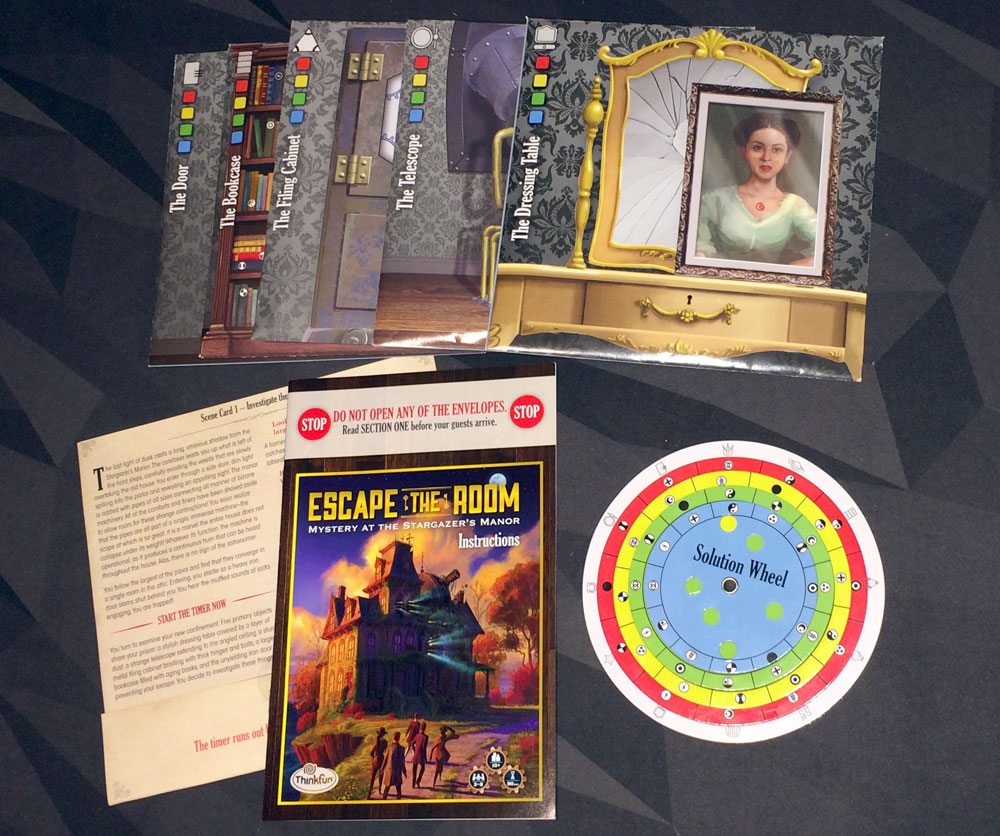
I won’t spell out all of the components, since some of them are surprises, but here’s the gist of what you get:
- 5 scene envelopes
- 1 Solution Wheel
- 1 Scene Card 1
- 1 instruction booklet
Each of the scene envelopes has a title and an icon next to some colored squares, plus a large image on the front. The icon and colors correspond to the Solution Wheel. Each of the envelopes includes various other components, including additional Scene Cards and even some more envelopes. The envelopes are sealed with small stickers, so opening them usually tore a little bit of the paper. You can play it again, but the envelopes won’t be actually sealed after the first time you play.
The Solution Wheel is a clever little contraption made of 5 disks that spin independently. Along the outer white ring are various icons, some of which correspond to the icons on the envelopes. The colored rings have various symbols on them. Each of the discs has a pattern of holes punched through it. When the correct icons are lined up, icons will appear in some of these holes.
The Scene Cards have little bits of the story written on them, along with some instructions. They’re designed to be read aloud when discovered, and they kind of serve as the game master, describing what you see and telling a bit of story. The illustrations on the envelopes are nicely done, with lots of little details that you can pore over. Without getting into the details of what’s inside the envelopes, I think the components are pretty well done but nothing really extravagant, either. Basically, things work the way they’re supposed to.
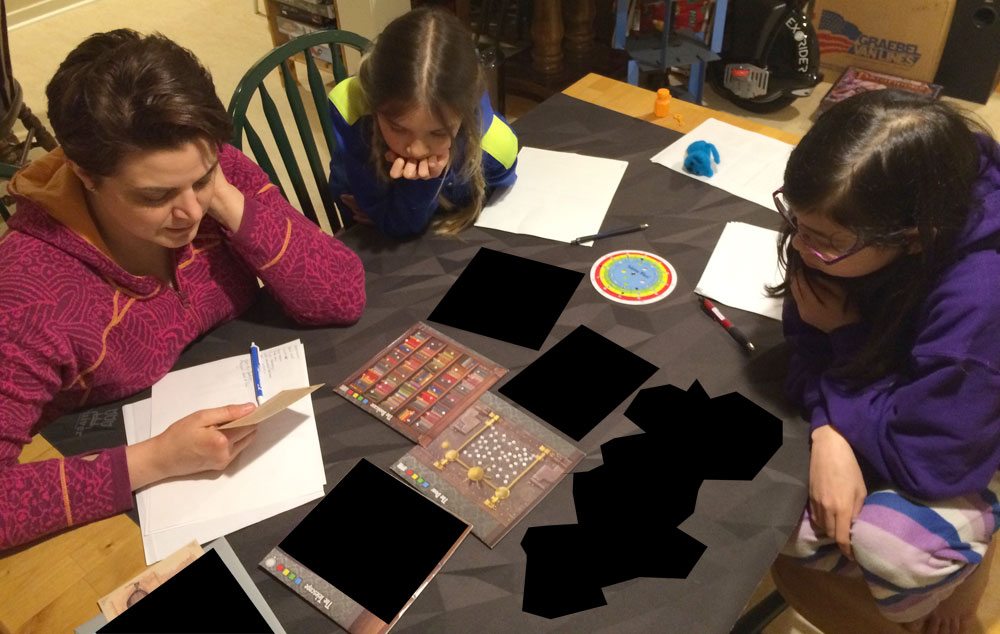
How to Play
I won’t spoil the story, but basically you and your guests have gone to investigate the manor, and find yourselves locked into a room. The five envelopes represent the various things you can see in the room, and the Scene Card 1 tells the story of how you got there. The goal of the game is to get through the puzzles and escape the room.
You’ll need to set a timer for the game, based on the number of players. The rulebook suggests 2 hours for 3 to 5 players, and 90 minutes for 6 to 8 players. I think when we played, it took us roughly an hour, so I think that’s really an upper limit. If you get stuck on a puzzle, there are also hints available online.
The puzzles are a mix of physical puzzles and clues that require your observational skills. Each envelope represents a door, or box, or something that is currently locked or closed. When you find the right code, you’ll be able to open the envelope, progressing through the story and discovering some new clues (and puzzles). When you put in the right code on the Solution Wheel, the appropriate icon will show through two of the windows in the center, and the next envelope is unlocked.

The rulebook says not to use brute force to find the solutions–that is, don’t spin the wheels looking for the icons to show through. I mean, you could do that, but you could also just open up all of the envelopes and read the story, which defeats the purpose of the game.
You have until your timer rings to solve the puzzles and escape the room–or else face dire consequences! There are a few scene cards that have additional flaps to unfold based on choices you make or running out of time.
The Verdict
I had mentioned before that my two older daughters have really gotten into escape room games recently, and they were bummed that they didn’t get to come to Labyrinth with me, so this escape-room-in-a-box seemed like a great way to bring the experience home. Granted, it’s not quite the same as being in an actual built environment, but it was also a bit more real than the online games they play. The experience is also something in-between.
For one thing, in this version, everything you get is useful somewhere. You won’t be sure which parts of the illustrations are important and which are just decorative, but at least all of the physical elements in the envelopes will be used for something, which is similar to the online games: there generally aren’t “useless” items that you can pick up. In a physical escape room, there may be furniture or decoration that’s just there to add to the atmosphere.
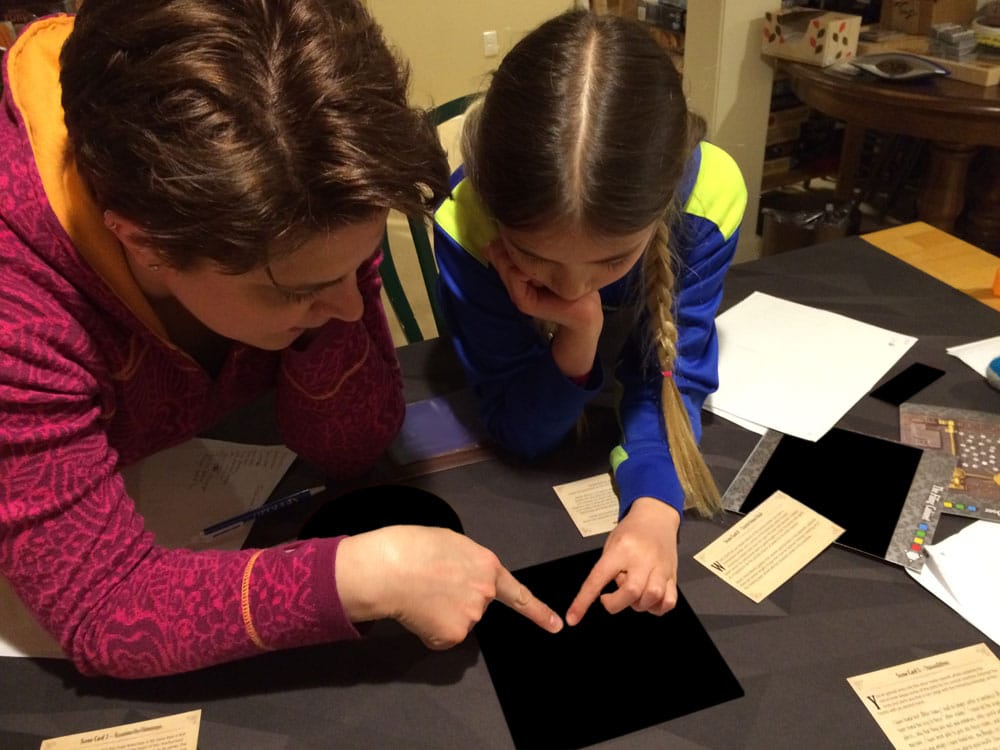
We took turns reading the scene cards and turning the dials on the Solution Wheel (because everyone wanted a chance at that). I did like the mix of types of puzzles: you really had to look at all the pieces and pictures, and pay attention to the story, because you never knew when something would be important. You would get pieces in one envelope that didn’t make any sense until you managed to open another envelope later. The path through the puzzles is linear–because of the way things are sorted into the envelopes, you can’t solve things out of order, so the Scene Cards will make sense.
Escape the Room is designed to be solved once, because after that you’ll know how the puzzles work. However, my kids like to play the online versions over again, and I can see them doing that with this puzzle, too, like a story you enjoy reading even though you know how it ends. On repeat plays, you will still have to complete the puzzles to find the code (because you probably won’t remember those), but it will go faster because you won’t have to spend as much time figuring out what the puzzles are.
And, of course, if you want to host a group of new players, they can have the full experience (as long as you don’t give away the answers) except that the envelopes will have been opened before. There are even instructions on Thinkfun’s website about reassembling the envelopes in case you didn’t take notes about where everything came from.
So is it worth the entrance fee to the Stargazer’s Manor? I think so, and my family agrees. Even though it’s essentially a play-it-once experience, it was a fun hour or so of entertainment that we were able to enjoy as a family–and it’s a nice, cheaper alternative to the real-world escape rooms. I think it would make for a fun party activity, too, especially if you wanted to play up the theme with music and decorations–kind of like those murder-mystery parties where you asked people to show up in costume.
Thinkfun’s website shows that there’s a second kit coming soon, Secret of Dr. Gravely’s Retreat. From the cover art and description, this one looks to be a bit creepier, so we’ll see if my kids like that one as much.
Escape the Room: Mystery at the Stargazer’s Manor is in stores now, or available at Amazon.
Disclosure: Thinkfun provided a review copy.

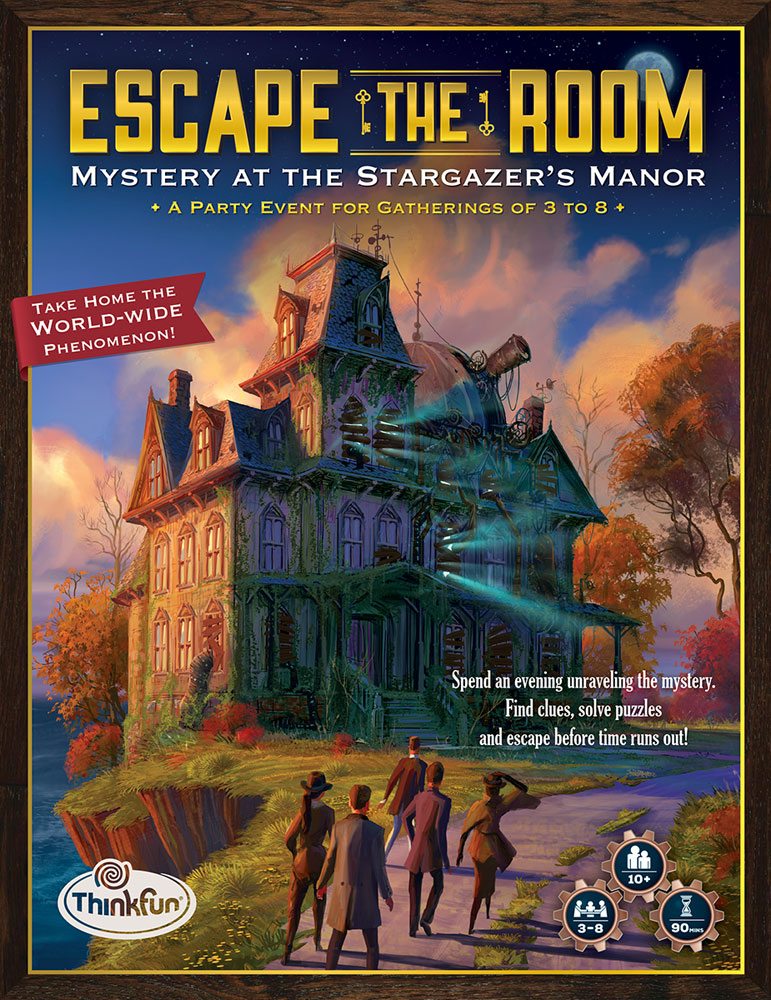


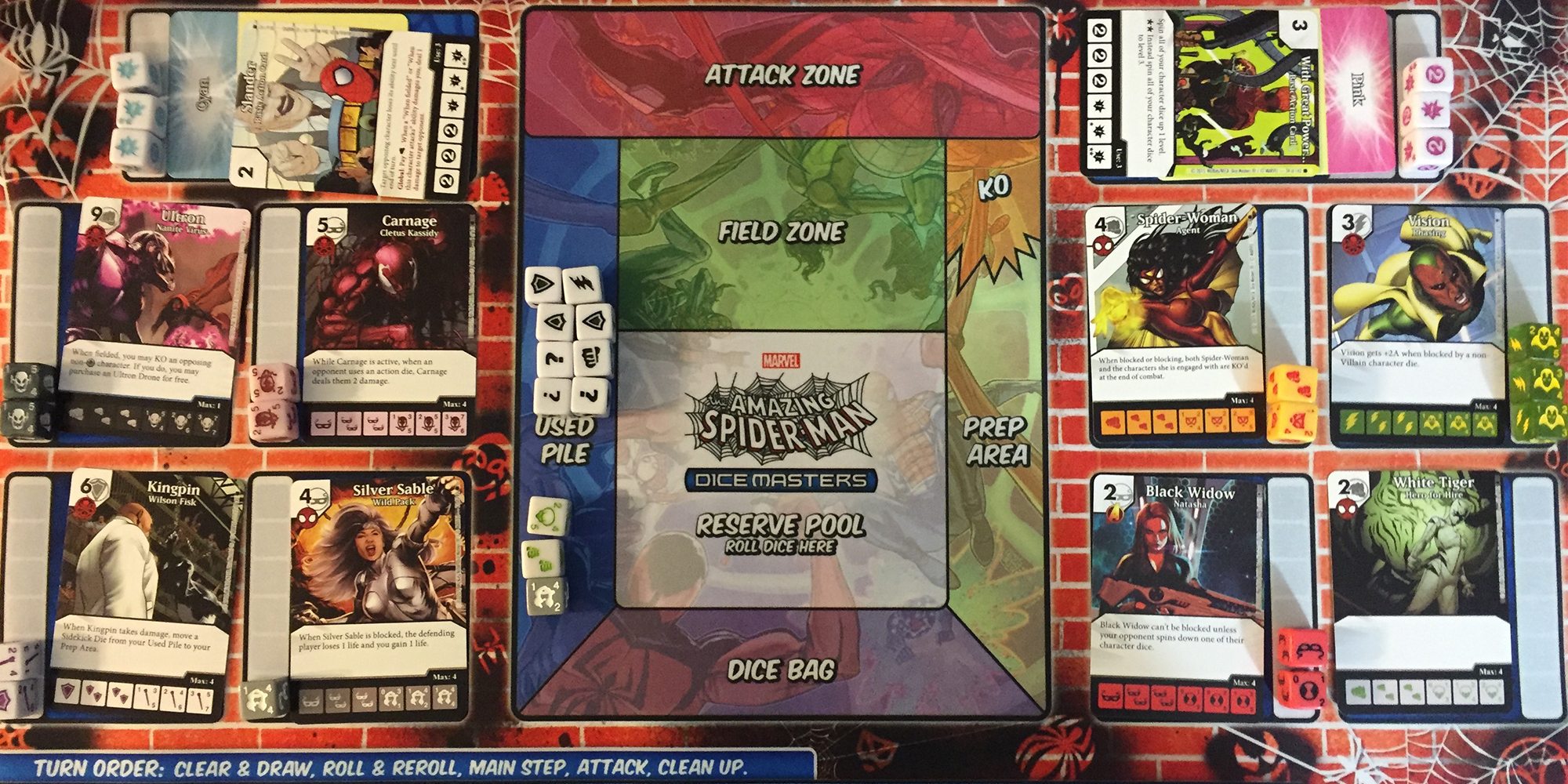
Was interested in this, your review is certainly thorough. But after looking at the reviews on Amazon, I see there’s no re-playability for folks who have played it. (I expected the replay to be something like Clue, maybe.)
Jonathan’s review clearly states it’s a play-once game.
Ah, I must’ve missed that. Still, that’s just the killer for me when it comes to purchasing games. I guess it’d be neat to hand it off amongst a group of friends, $22, then , $21, etc. and the last guy to get it pays the second-to-last guy just $1. You know, if your circle of friends all have kids or large families.
Yeah, I would say there are portions that are replayable, but you’ll already know the experience. It would be something like replaying a video game—you know what to look for the second time around, but you still have to find it. Although this is packaged something like a board game, it’s more like an experience, so in my mind I compared the price to, say, taking my family out to see a movie, or (an even closer comparison) buying them all tickets to one of those escape room experiences. But compared to a typical board game, no, you won’t get the same dollar-per-play value.
We opened our game today and are missing both the instructions (which I can view the pdf online) and the scene 1 card. Any way that you could take a picture of the scene 1 card and post it? Thanks if you can help us; I hate to return it to the local game store just for one piece of paper!